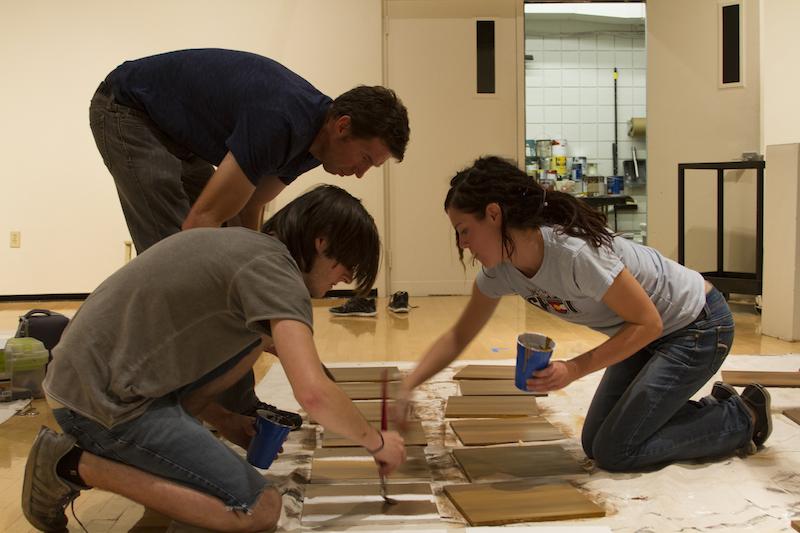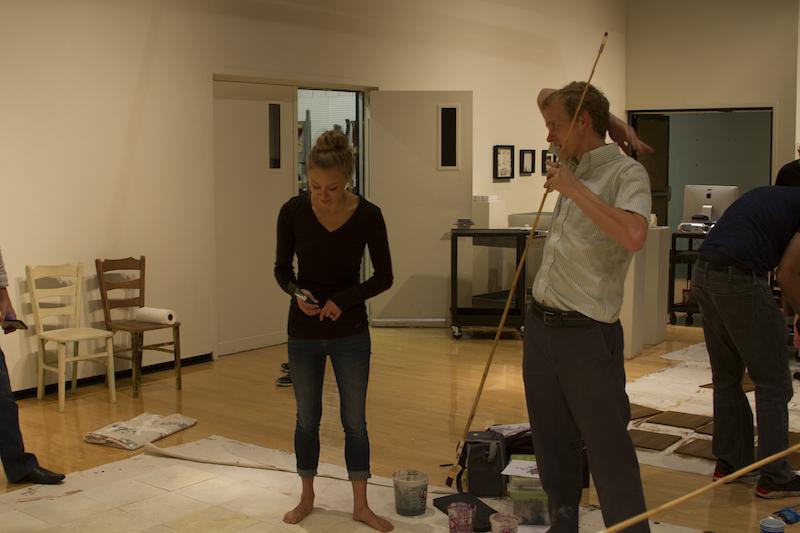GALLERY: Collaboration exhibit gives insight to lost minds
Sophomore Gabby Siekman, Kevin Muente and Jack Seiter paint tiles that are part of the piece. The exhibit runs until Oct. 30.
No matter how gone a person suffering with Alzheimer’s may seem, that person is still there even though they may appear to be a shell of their former selves.
That is the concept that Liliana Duque Piñeiro wants to express in her new exhibit, “Theatre Sets of Liliana Duque Piñeiro, Limonar: Reflections About Alzheimer’s” showing in the Main Gallery in the Fine Arts building.
Inspiration for the exhibit came from a character that she was already trying to work into a piece. The character was taken from an opera called “L’enfant et les sortilèges,” or “The Child and the Spells by Ravel.”
“In the story, the little boy takes one of his favorite books and he rips it… He’s throwing a tantrum,” Piñeiro said. “The character [from the book] comes alive and kind of tells him, ‘Look, I used to be your hero and now look at what you’re doing. I’m all torn.’ I was working with that character and trying to develop it.”
At the time that she was looking at this character, she found out that her mother was diagnosed with Alzheimer’s. Piñeiro said that she took working with that piece as a way to cope and use what she was experiencing.
“I used that piece that I was creating to deal with my own personal experience,” Piñeiro said. “Just having my own hero being… Just fading away. Disintegrating, in a way, her memory.”
Piñeiro also pulled from other art that would help add to her exhibit. One of those is an opera called “Alzheimer’s Stories” composed by Robert Cohen because it told different stories that others could relate to and that it didn’t just follow her mother’s story.
She also found a set of plays from a collection called “Memorycare” where it tells not only the patients’ stories, but the caregivers’ stories.
The exhibit will demonstrate the idea of collaboration from the School of the Arts.
“The exhibition came to be because they are now School of the Arts,” Piñeiro said. “Now they wanted to have an exhibition which would combine everything this school represents.”
Theatre and dance, art and music students are taking part in the exhibit. Art students are working to paint the sculpture pieces that are put on display in the gallery.
On Oct. 1 and 2 , there will be a live performance in the gallery. Theater and dance students will take part in readings and acting in some of the pieces. For example, a professor will play the part of the Alzheimer’s patient who does something that triggers former memories and students will play the parts of family members or caretakers.
Senior theater major Sophia Ash will take part in one of the performances as Karen Monstien, the middle daughter of Alzheimer’s victim, Arthur Monstien played by associate professor Mike King.
“You see how Alzheimer’s affects Arthur,” Ash said. “But you also see the effects it has on the children.”
The character of Arthur is seen struggling with the disease and often asks where his wife is even though she has passed away. His children are each affected differently, but Karen ends up being the main caretaker.
“Karen has two young children and is the main caregiver,” Ash said. “She kind of babies him [Arthur].”
Ash said that she has experienced dementia in her family and said that there were times during the rehearsal that caused her to feel emotional.
“There are moments where… they don’t know who they are,” Ash said. “And other times, they are clear.”
There’s a scene where the oldest son is explaining to Arthur that his wife is dead.
“You see him almost grasp it and then he asks, ‘What’s your name again?’” Ash said. “And that got me.”
The music students will add the music that will be played during the performance.
Each piece in the exhibit tells different stories of Alzheimer’s patients. One piece has a beach chair with a sewing machine. The character for that piece will look at some thread and the waves remind her of a beach and that’s what triggers her memory.
Another piece features a table with a puzzle on it next to a chair. The puzzle is half complete of boys playing as sailors. Underneath the puzzle, on the other half, shows pictures of Navy men. The man who is putting the puzzle together triggers a memory of being in the Navy by seeing the puzzle.
Each piece triggers a memory in the character, but when there aren’t characters present, there are chairs set up.
“The chairs represent an entity,” Piñeiro said. “They’re proportioned to the body.”
An observer of the gallery can then envision a person being there when there isn’t a performance going on.
David Knight, NKU gallery director, said that there are about 10-14 faculty members and 25-40 students working on this exhibit to pull it together.
“It was going to be very transdisciplinary,” Knight said. “Which is a big thing at the university to integrate. So far, in the last few weeks, it’s been great.”
Knight said that he and students in music and theater and dance have been interacting more with each other.
Other faculty members will take part in the exhibit. Brian Robertson will help with stage direction and music head Eric Knechtges will direct the music.
Overall, the experience of working with the students has been a good one, according to both Pinñeiro and Knight.
“Everyone has been positive,” Piñeiro said.
Piñeiro said that she hopes that the observers get a lot out of the exhibit. She hopes that people who don’t have that disease in their life will appreciate that and people who do have Alzheimer’s in their life, realize they are not alone.
“If you can teach someone about a disease through art,” Ash said. “That’s really important… It’s so real.”
The gallery will remain open until Oct. 30 and tickets will be available for the performances on Oct. 1 and 2. The event is free, but seating is limited so contact David Knight at knight@nku.edu for reservations.
Your donation will support the student journalists of Northern Kentucky University. Your contribution will allow us to purchase equipment and cover our annual website hosting costs.



